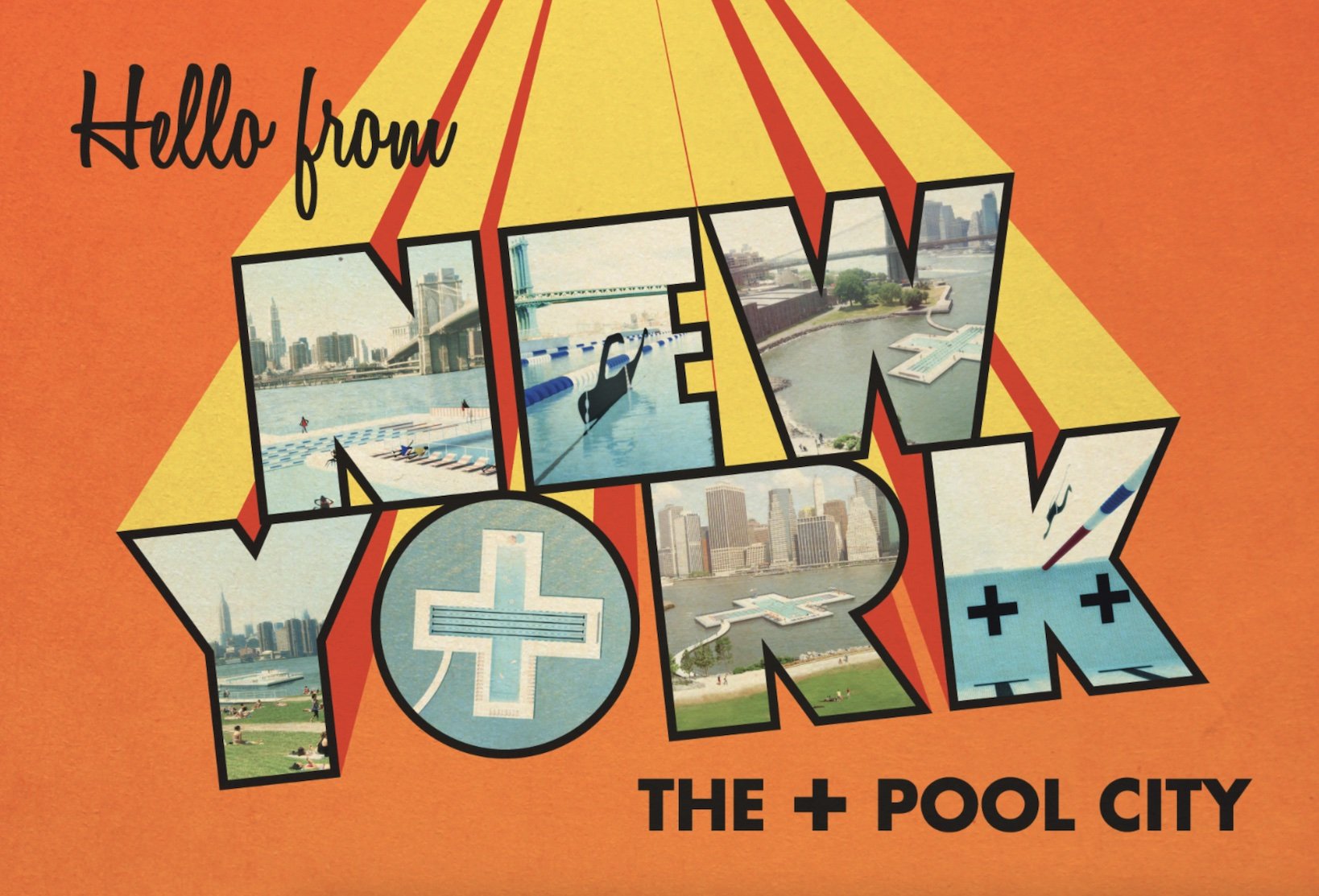
Looking back—albeit still at a relatively short distance—the first 15 years or so of the current century look like a high-water mark for a certain giddy, techno-positive brand of city-building in New York. Following a long interval of earnest, ho-hum downtown redevelopment, a growing chorus of “Why don’t we think big anymore?” started to find an answer in imaginative proposals from architects and civic leadership that promised to make cities exciting again. Towers atop train tracks, elevated greenways, rooftop farms: Even the most far-fetched ideas, it seemed, managed to get traction and get built.
And then there was the “floating swimming pool for New York that [will] filter river water through its walls,” as design vertical Dezeen described it in 2011. Cooked up a couple years earlier by a group of daring designers, Plus Pool (styled as + POOL)—a proposal for an innovative outdoor natatorium on Gotham’s East River waterfront—caught fire with the public and with a media primed for just such far-out architectural notions. Shortly after its debut, it popped up in the prestigious Architectural Review, got a shout-out on Jay-Z’s blog, and has since racked up some $300,000 in Kickstarter campaigns.
With its vision for a high-tech water purity system and glamorous aesthetic, the scheme appeared perfectly calibrated “to make Mayor Mike Bloomberg swoon,” as one newspaper put it. Besides rounding up some more cash, resolving a few bureaucratic knotty points, and bringing the unrealized design to fruition—plus maybe figuring out how to engineer it—nothing seemed to stand between millions of people and a warm-weather fun park like no other. “We thought we were going to do this in four years,” recalls Archie Lee Coates IV, a co-founder of the Plus Pool initiative and the interdisciplinary creative agency Playlab, Inc.
That was 13 years ago.
“We have supporters tapping their feet,” admits architect Marc Kushner, former board chairman of Plus Pool’s now 8-year-old nonprofit, Friends of Plus Pool. (Its current chairman is government affairs advisor George Fontas.) “It’s just so hard to do anything in this city.” He has a point, of course: a decade and change amounts to very little in the geological timescale of infrastructure in New York. This is a place, after all, that took nearly a century to open a (still incomplete) subway on Second Avenue.
Nevertheless, to the relief of Kushner and the project’s immensely patient fan base, Plus Pool is still moving forward, with greater institutional and popular support than at any time since it first burst onto the scene. Still, by the time the pool arrives, it will likely have been a few decades since its creators first started circulating their custom-made zines and posters, filled with lofty language and alluring images of New Yorkers frisking about in their long-neglected waterways.
By now, many know the project’s fits-and-starts saga. But what have its designers learned from their predicament that they are using to refine their tactics and press on? Is devising a way to safely swim in the notoriously filthy East River a worthy design pursuit after all?
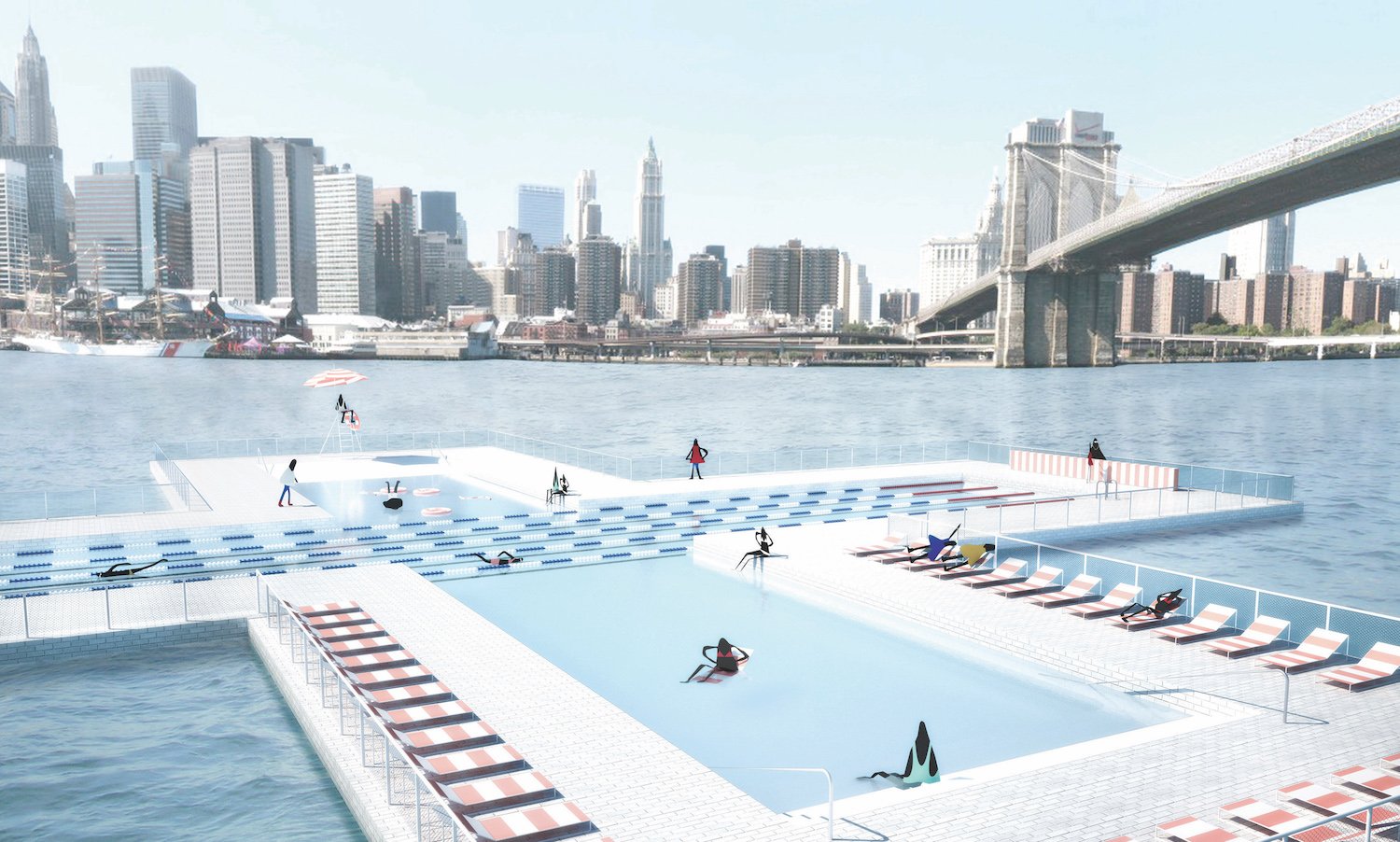
“We were all really young,” says Coates, reflecting on the plight of the pool. In 2009, he had just incorporated Playlab, which was founded six years prior. The slow recovery from the Great Recession was in full swing, and jobs were in short supply. But free time was abundant, allowing the company to pursue inventive, quasi-commercial endeavors such as its popular early initiative Pielab, a (now closed) social justice–minded pastry shop in Greensboro, Alabama.
The project caught the eyes of architects Dong-Ping Wong and Oana Stănescu, acquaintances of one of Playlab’s partners and who had recently set up a design practice, called Family, in the city. (Wong, who did not respond to interview requests for this story, now runs a Chinatown studio called Food; Family dissolved in 2018.) “He just thought it was crazy that architects could launch their own ideas,” Coates recalls. “In architecture, it’s usually the client who approaches you.”
Rather than waiting around for commissions, Wong contacted Coates and company with an ambitious idea of his own that he hoped Playlab could help get off the ground. Prior to creating Family, he served an extended apprenticeship at REX, the Manhattan firm of architect Joshua Ramus; the experience had given Wong a strong grounding in cutting-edge technical and conceptual trends, but also left him wanting something more.
Describing his experience in private practice, Wong told an interviewer, “We would work so hard on an idea and then the partner would come in and just take a piece of trace [paper] out, literally just draw [a] shape and be like, ‘Let’s just do that.’” Looking to pursue his own ideas on his own terms, Wong started working on something entirely new—a concept more playful, yet more socially engagé, than anything he was likely to get away with at the office.
As presented to Coates (and unchanged in the years since), Wong’s concept called for a large aquatic facility to be located not alongside New York’s waterway, but floating within it, filled with actual river water and capable of hosting large numbers of people during the warmer months. Easily accessible via walkways that would connect it—as well as moor it—to the nearest bank, the pool would serve a double purpose as an ecological amenity, deploying as-yet-undeveloped technology to filter the water within and render it cleaner than when it arrived.
Adaptable to multiple locations, the facility would also have multiple uses, its cross-like configuration providing four discrete swimming areas that could be occupied by various ages and types of swimmers. Family’s multi-armed plan combined neatly with the branding conceit advanced by Playlab: This wouldn’t be just an ordinary pool, but a pool and then some, a way to change New Yorkers’ collective attitudes toward the blue-green brine that surrounds them. Thus, Plus Pool was born.
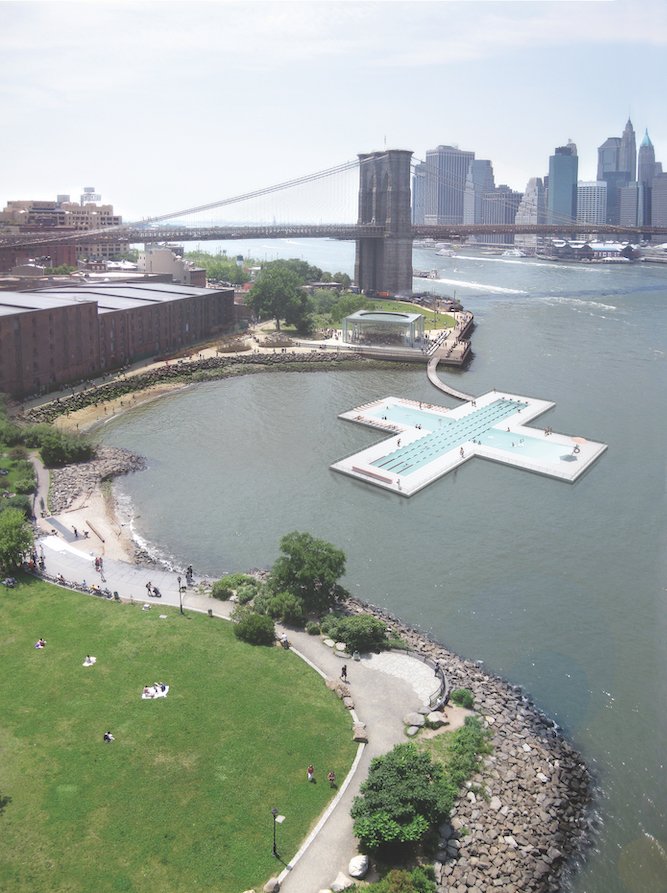
As much as it was a creature of the 2010s, and of Bloombergian ferment, the Playlab/Family proposal also had deeper roots in architecture and planning culture. River swimming was once a major component of New York City life: Public baths freckled its waterfront in the 1800s. Until the early 20th century, locals observed Launching Day, an annual early August tradition of throwing one another into the water for a somewhat unexpected cooldown in the height of summer. More recently, urbanist Ann Buttenweiser has spent much of the aughts attempting to bring those shorefront bathing traditions back, finally succeeding in 2006 when her barge-born Floating Pool debuted in Brooklyn Bridge Park.
Plus Pool was a hit with the design community from the start. And with good reason: Beyond just the gee-whiz prospect of swimming in the shadow of Manhattan’s skyscrapers, the proposal appeals to multiple camps within urbanism and adjacent fields, from climate-change experts (who view pools as a key adaptation to a warming planet), to public-health mavens (looking to combat childhood obesity with public swimming programs), to social equity advocates (with so many penthouse swimming pools these days, why not one for the people?).
But from the moment its creators started to shop it around as a buildable reality, they found that some had their doubts. As Wong told the podcast The Second Studio (formerly the Midnight Charette), in 2019, the team had “accidentally inverted” the entire design process—garnering media attention before actually determining whether their concept would work—and now had to build “an engineering team around the idea.”
The fact that the project’s filtration system had yet to be invented was obviously cause for concern. But that hurdle was overcome with surprising speed: As early as 2011, the team found themselves in serious conversations with engineering giant Arup, who declared that the basic technical brief—a mechanism that could render the still-polluted New York waters safe and swimmable—was indeed feasible, and not even outrageously pricey, estimating a cool $21.5 million in all. Doable, however, did not mean done, and a host of daunting regulatory issues remained. Knowing they would need outside assistance, Family and Playlab went knocking on doors.
Some shut in their faces, only to open again. “Joshua David said, ‘This is amazing, but you’ll never get it done,’” Coates says. David, one of the prime movers behind the wildly successful High Line park on the West Side, was dubious that the scrappy young team could jump through all the bureaucratic hoops necessary to bring their idea to life. Yet within a few months, David appeared to come around, advising Coates and Wong to follow in his own Friends of the High Line footsteps and create a nonprofit foundation—and to put him on the board, as well as chairman Marc Kushner, who recalls thinking, This looks like it’ll be easy.
The board, in turn, reached out to cultural-institution veteran Kara Meyer, most recently of the Storefront for Art and Architecture, to take the reins as Plus Pool’s first (and so far only) managing director. “It felt like there was this groundswell of public support,” she says of the time. “Like, we have to do this.” It was 2015, already six years since Coates and Wong’s first meeting. While the building blocks for Plus Pool appeared to be in place—some of them quite literally, following a fundraising drive that promised to emblazon donor’s names on the pool deck tiles—Meyer and her intrepid crew still had a long journey ahead of them.
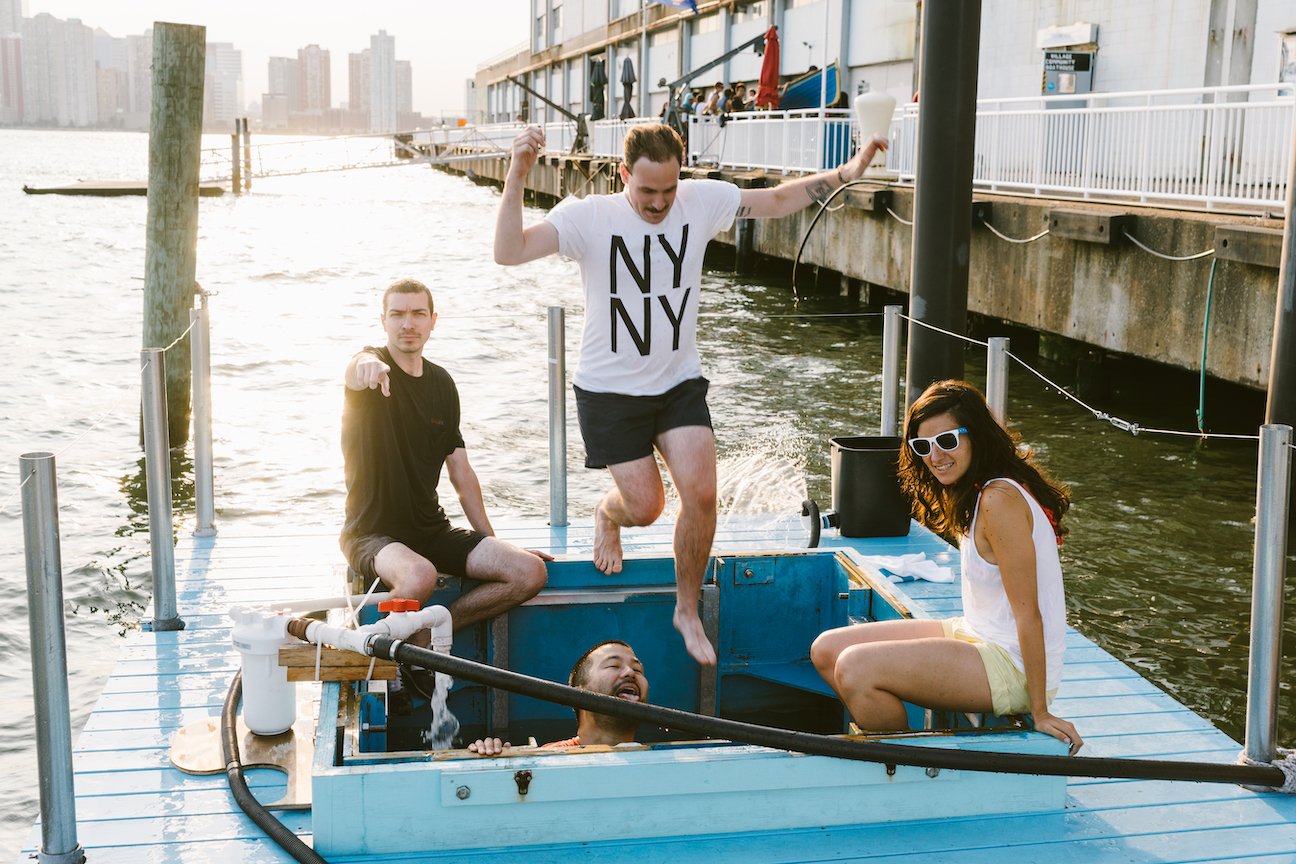
A couple weeks ago, Meyer sat on a bench near the South Street Seaport. “You can see this barrier to the water,” she says, pointing to the extensive fencing, roadways, and other bulwarks that line the perimeter of Lower Manhattan. “Don’t you just wanna jump in?”
For Meyer and her collaborators, the obstacles that have kept them from making that final leap have been too numerous to recount. “Some of them are just bad luck,” she says. By rough estimate, Meyer and other Plus Poolers have appeared before the city council on at least three occasions (though not in relation to building the pool—they were there namely to advocate for bills that its organization supports, including the creation of an office of the waterfront and water safety legislation). They’ve had to walk out of a meeting after a real estate mogul tried to privatize their idea. They’ve been denied planning funds by the Regional Economic Development Councils (the organization currently has a pending application), they’ve been denied insurance by multiple providers, and they’ve been at least threatened with the denial of donations by former contributors, baffled as to why everything is taking so long.
Of all the reversals faced by the team, two in particular stand out. The first was not in any sense particular to them—the Covid pandemic effectively put the entire project on hold, obliging the team to furlough its staff and put off vital meetings with city officials for the better part of two years. Longer still however, and even more frustrating in effect, was another issue that arrived earlier in the project’s germination. “When de Blasio came in, we knew that we were absolutely not going to be a priority,” says Coates. With the change in occupancy at Gracie Mansion, the project was effectively orphaned, viewed with suspicion by a new mayor eager to distinguish himself from his predecessor.
But today, the shifting winds of politics may actually be blowing in Plus Pool’s direction. From where she sat on the East River the other day, Meyer could look north to just beyond the Brooklyn Bridge, to a spot on the Lower East Side where Plus Pool has lately secured a bona fide, officially endorsed site for future construction. Approval for location came from the New York City Economic Development Corporation in 2021, mere months after Mayor Eric Adams came into office. “We really needed an advocate like Adams,” says Kushner. Though no one is prepared to say when work might get underway (much less when it might wind up), momentum appears to be building once again.
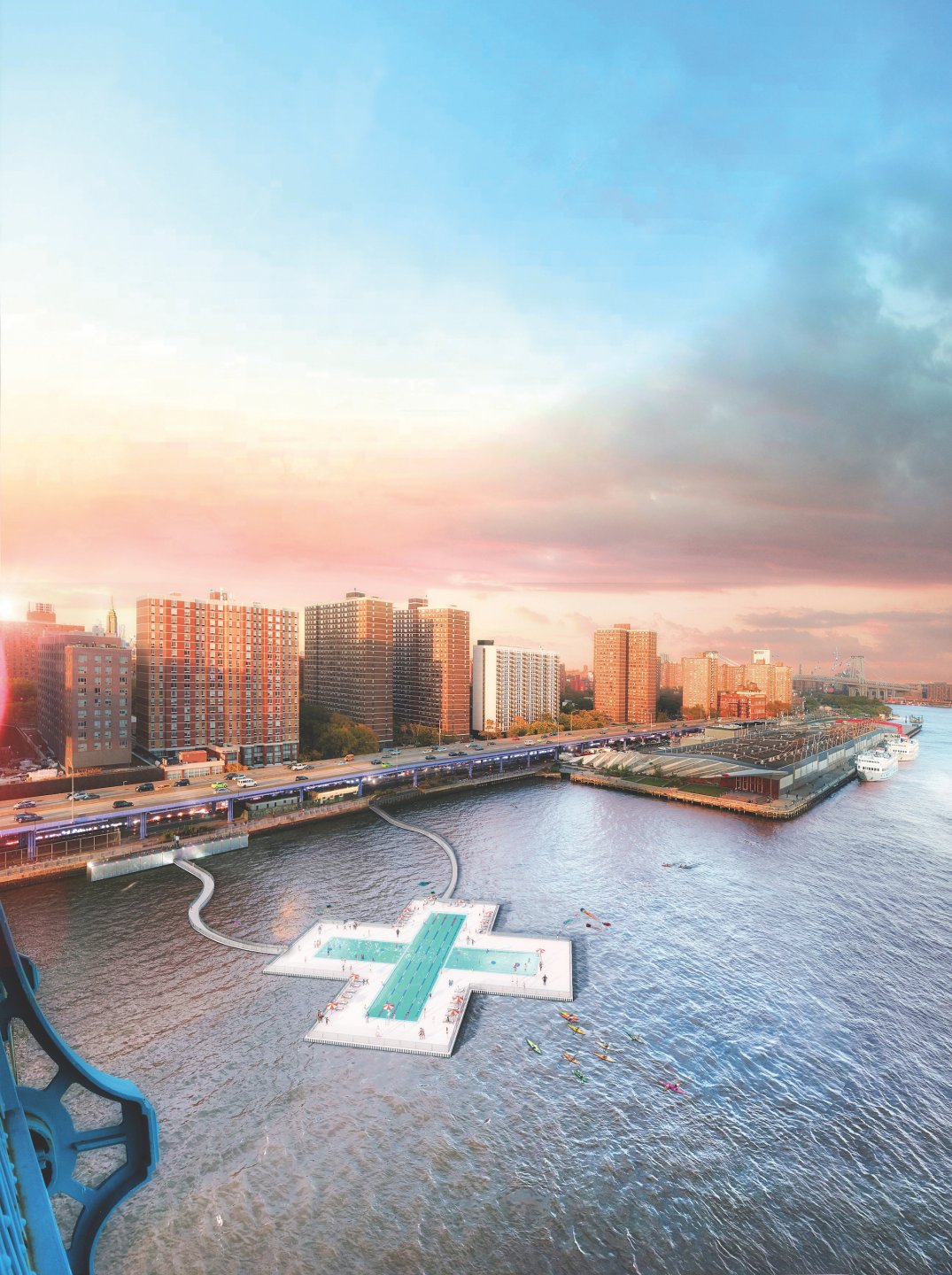
And yet one has to wonder: Has it all been worth it? After so many years and so much effort, Plus Pool might be regarded simply as an object lesson in the perils of trying to do anything bold or unprecedented in a city as large and complex as New York. But for those involved, the chance to do something that no one had ever thought possible seems to have been enough to keep them working the phones, taking meetings, and making public appeals. And while the core design concept has remained largely unchanged, Plus Pool—or at least the organization behind it—is more than merely an artifact of the very different architectural climate (indeed the very different city) where it first came to be.
“Our mission has always been to provide free and safe access to the water,” says Meyer. “Part of that involves raising awareness.” As they’ve waited for their diving-board dreams to materialize, the nonprofit behind the project has been actively engaged in fighting for pro-swimming legislation in Albany, hosting recreational events around the five boroughs, and generally becoming a social advocacy group with a far larger remit than the one it started out with. In this regard, Plus Pool has moved in parallel with the overall evolution of the design world, as well as the public at large in New York, both of which have become increasingly alive to pressing questions of inclusion and equity in the last decade and change.
Even if Plus Pool never materializes (and certainly its creators don’t care to think about that), it has already done much to justify all the effort, patience, and sheer hair-pulling that have gone into getting it this far. “Every single day, I think about quitting my job,” says Meyer. “But we’re now in a really cool phase.”